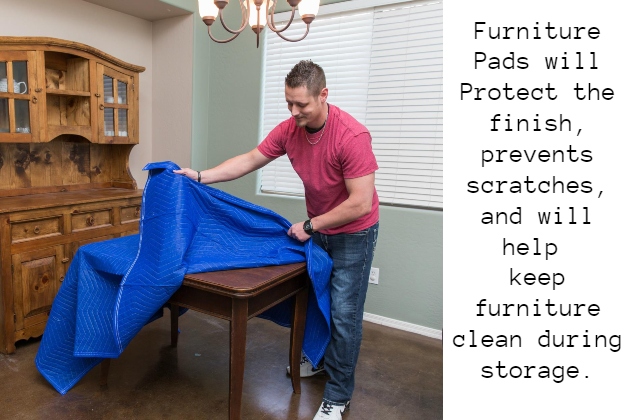
Preparing furniture for storage is critical. Furniture is expensive. Not preparing it properly before storing, will ruin the furniture. Who has the extra money to replace ruined furniture. There are several things that can be done to prevent damage. As with anything going into storage, furniture takes a little prep work. Firstly, knowing what types of materials the furniture is made from is important. Next, what types of cleaners work best on the material. Then the proper way to clean it. Lastly, once it is cleaned and dried what final steps can be taken to protect the furniture going into self-storage. Therefore, preparing furniture for storage will help save your investment.
Materials:
Furniture comes in many styles and materials. First it is important to know what type of material before cleaning. For example, wood requires a few steps, but plastic or plastic resin furniture is a wash and dry method.

Wood furniture should be dusted first with a damp cloth. Next, wash with a mild solution of soap and water. Murphy’s oil soap is a great cleaner for all types of wood. Then allow to thoroughly air dry. Lastly, oil or polish furniture. Cleaning ensures that no contaminants like food or mold and mildew follow your furniture into storage where unchecked they can damage wood.
Resin or plastic furniture should be dusted first. The best method is with a vacuum cleaner and the soft bristled brush attachment. Especially as most resin furniture is textured. Next mix a solution of mild detergent and water. Hose down the furniture and then wash with the solution. Then rinse thoroughly and allow to completely air dry. If the hose option is not feasible, hand wash the furniture. Then use a sponge and clear water to rinse. Be sure to rinse sponge several times to remove all the detergent.
Metal furniture is easy. Inspect for rust and remove as this will continue to oxidize during storage. Next, wash with a mild non-detergent soap, rinse, and completely dry before storage. If the rust removal took place, repaint the damaged area to further protect the metal.
Leather furniture should be stored in climate controlled; leather is extremely porous and will succumb to moisture and heat. If climate controlled is not available be sure to use a good leather cleaner and follow with a great conditioner. Accessing the storage unit a few times a month will allow fresh air to circulate through the unit helping keep the unit dryer.
Cushions or Fabrics:
Cushions come in two kinds, removable covers and non removeable. If the cover is removable, remove it and wash in the washing machine. Then prepare a solution of mild soap and water in a bucket. Wash the inserts and rinse thoroughly squeezing as much water as possible from them. Allow them to air dry. It is particularly important to allow them to dry completely. They will mildew in storage if not completely dry.
Non removable covers take a little extra work. Sometimes the best option is to use an upholstery cleaner, for the fabrics that can be cleaned with one. If after the patch test the material shows it should not be cleaned with an upholstery cleaner, it will require hand washing. A patch test is recommended if the material has never been cleaned before with an upholstery cleaner. The patch test consists of testing a small area first to see if it damages the material.

If a patch test shows you cannot use upholstery cleaner follow these steps to clean the cushions. First, brush any crumbs, dirt, or loose material from the cushion. Next, mix a solution of mild soap and warm water. Then wet the cushion and brush gently with a soft bristled brush to remove any stains or grime. Once the exterior of the cushion is cleaned, gently submerge the cushion in the solution and squeeze. Remove from the water and rinse in clean water until there is no more soap in the cushion. Finally, allow to air dry until the cushion is thoroughly dry.
For best storage of cushions, wrap in plastic or if they are too large then place them together and cover them with a tarp, sheet, or other covering to protect them from dust.
Glass Tops:
Glass comes with its own cleaning requirements. Use cotton gloves to avoid greasy fingerprints. Grease can cause mold and mildew when being stored. Clean the glass and remove it from the base if possible. Wrap the glass in a protective layer. You can use bubble wrap, furniture pads or blankets. If the top is round, use cardboard to create a box for the wrapped top. This will help prevent rolling and add an extra layer of protection.

Storage Hints:
Now that the furniture is clean and thoroughly dry. Let us look at how to prepare the furniture for self-storage. First, is the furniture easy to disassemble? If it can come apart take it apart! This step will save space in storage. For example, a table taken apart will require less space to store than if it was fully assembled. Next be sure to secure all hardware to assemble the furniture in a zip lock bag and tape to the backside of the furniture. When it comes time to assemble the furniture after storage everything you need will be with the furniture.
Next, if the furniture has drawers, such as a bureau, take them out. Moving the furniture will be easier. Once it is in storage put the drawers back. Do not forget to use that extra space for storage! This will provide an extra layer of protection for fragile items. To utilize this space, wrap fragile items in bubble wrap and pack into the drawer, then close the drawer. Any added layer of protection for fragile items is a bonus!
Lastly, for items such as couches, cover the couch with a sheet, or other covering. This will help keep the couch from getting dusty. Also, it is best to add a dryer sheet or two to help keep the couch smelling fresh. When the items come out of storage allowing them to spend a little time in the fresh air and sunshine will assist in freshening them up.
Added protection:
During the moving process damage can occur to furniture. Things like scraps to the finish, a leg can break off, or any number of things can happen. One of the best ways to prevent damage is to use furniture blankets. These handy blankets will protect finishes and can be used as covers in storage to prevent scratches and dust.

Another moving must, especially for sizable items is the furniture dolly. These come in several sizes and styles to assist in moving furniture safely. One is a two-wheel dolly. These are great for moving midsized items.

Next are little four-wheeled dollies. These can be used individually or in combinations based on the size of the furniture. They make moving bulkier pieces a breeze. Therefore, If the item is an oversized piece, consider renting a furniture dolly to assist with moving.

If the furniture has any value, go with a climate control unit. The units are controlled to prevent excessive temperature changes which can damage wood, leather, and other materials. When the furniture is less than valuable and will be stored for a brief period, an outside drive up or traditional storage unit will work. As always, make sure the items in self-storage are covered with a homeowners or renters insurance policy. If not, purchase it at the self-storage location.
In other words, everything done to prepare furniture for storage is a step towards protecting your investment. A little prep work and insurance goes a long way towards making sure the money spent on furniture is not wasted.
Recent Comments